Reduced speed limits of 20mph (or less) and providing traffic calming are popular in town centre and urban areas. They improve road safety and increase the attractiveness of walking and cycling, as well as making residential and shopping areas more pleasant. 20mph limits will normally need traffic calming and/or other physical measures to be effective.
A range of measures can be used when providing traffic calming and introducing 20mph limits:
- Road humps (cushions and round-topped)
- Tables and entry treatments
- Sinusoidal humps and ramps
- Horizontal deflections
- Remove unnecessary carriageway width
- Road texture/surface
- Better pedestrian crossing provision
Speed cushions and round-topped humps
Speed cushions and round-topped humps were introduced quite widely in the 1990s after the enabling Highways (Traffic Calming) Regulations 1999, which gave some design criteria including the height limit of 100mm (4”). Both types were relatively cheap and simple to construct, particularly if constructed as asphalt overlays.
Speed cushions have become increasingly ineffective over the years, with wider cars as well as commercial vehicles being able to straddle them without reducing speed. This creates a more dangerous situation for pedestrians, who are dealing with variable passing speeds of 10-30mph and more. They also provide no crossing benefit to pedestrians as do other types of road hump. Cushions can create problems for cyclists by constraining their road positioning or giving them a sharp bump; cushions have a ramp gradient of 1 in 6, steeper than other humps. They can also destabilise two-wheelers if they contact their steep side gradients.
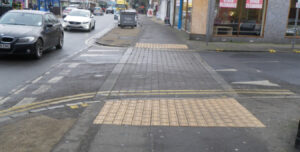
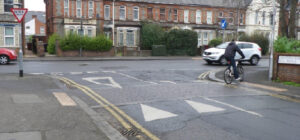
Flat-topped humps and tables
Other types of allowable humps were flat-topped tables with approach ramps; these could be used across junctions as well as beside junctions (entry treatments) and on straight links, subject to distance criteria. These are more expensive to construct than cushions, partly because road drainage changes are frequently required.
The benefits of these humps are mainly three-fold:
- Provide safer improved crossing places for pedestrians, with less variable vehicle speeds.
- Can be placed at junctions, which is where most pedestrians wish to cross.
- Can be ‘tuned’ to control vehicle speeds by height variations of between 50 and 100mm (2-4”) and varying ramp gradients, or see later, sinusoidal profile ramps. The length of the ramps can also be varied. This tuning means that humps can be designed to reduce traffic speeds to that considered appropriate at the location; this could be anywhere between 10 and 30mph. There will obviously still be a range of vehicle speeds depending on the vehicle type and the level of discomfort tolerated. Entry-treatments at side-road junctions have been shown to reduce cyclists’ collisions by a third.
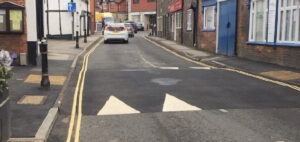
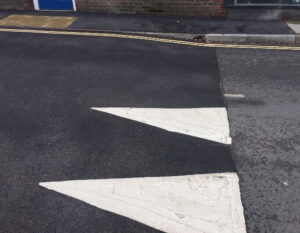
Sinusoidal profile humps
In the Netherlands the sinusoidal profiled humps are standard practice, and they are now used in a number of UK locations and recommended as the best hump in London Cycle Network and TfL guidance. Their main benefits are that they give effective speed reduction, but do not cause jolts to cyclists or poorly sprung vehicles. Sinusoidal ramps can be used in conjunction with flat-topped humps to provide pedestrian crossing areas.
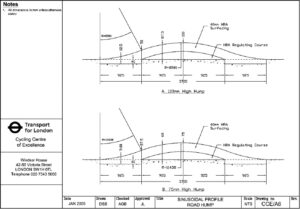
Humps at crossings
Flat topped humps can usefully be used in conjunction with Zebra or other crossings, helping to ensure that there are slower traffic speeds. This can also have the benefit of removing the need for expensive anti-skid (high friction) road surfacing on the crossing approaches.

Horizontal measures
Road deflections including width restrictions can be usefully used. Care must be taken not to create ‘pinch-points’ for cyclists. By-pass routes for cyclists should be incorporated where possible. Facilitating pedestrians crossing should also be considered. This may include a raised hump as part of the scheme.
Tightening corner radii and reducing unnecessary carriageway space should be considered in all schemes, along with streetscape measures to reinforce the sense of place.
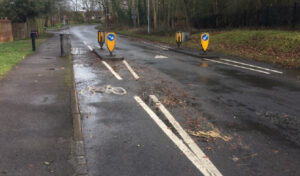
Good practice
When designing a traffic calming scheme, the needs of pedestrians and cyclists should be carefully considered, to enable the maximum benefits to be obtained.
Maximum use should be made of sinusoidal ramps and raised tables when humps are used, with humps ‘tuned’ to the individual location. Speed cushions and round-topped humps should be avoided wherever possible.
Changing the horizontal characteristics of the road such as tightening corner radii should be used when appropriate.
For other guidance see LTN 1/20 Cycle Infrastructure Design, Reducing Motor Traffic Speed Section 7.6.
John Lee
RBC Campaigner for RCC

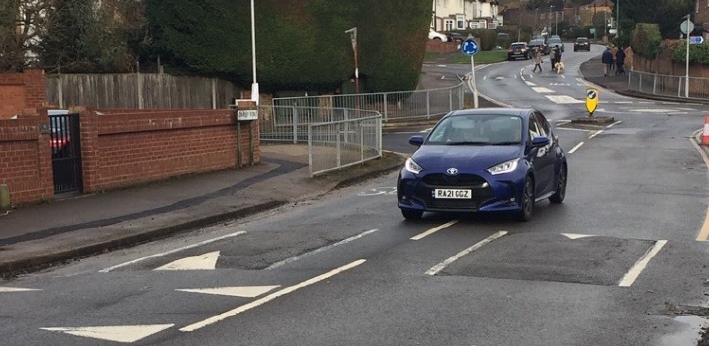
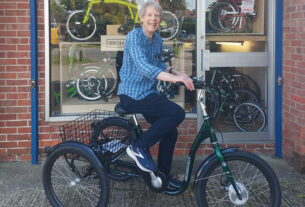
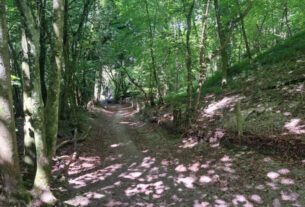
Looks like good stuff to a non-expert. Have you drawn it to the attention of traffic management staff at local councils?
When is Wantage Road going to be 20mph and when is the one-way system on the same road going to be enforced for all including cyclists?
Best practice for cyclists is to significantly reduce traffic calming; best practice for pedestrians is to improve or introduce new crossing facilities. I’d rather be overtaken by motorists doing 30 on an unobstructed road than at 20 where both motorists and I are having to negotiate an obstacle course of bump hazards and choke-point hazards. There are more than enough hazards to be looking out for on urban/suburban roads without deliberately introduced ones. “Pillow” bump hazards are particularly dangerous when placed close to junctions making achieving an appropriate road position to turn right for cyclists and motorcyclists an unnecessarily risky proposition . There’s a pillow bump hazard by parked cars on Redlands road which requires me to get much closer to oncoming traffic than I consider properly safe. Full-width bump hazards present other problems – the ones on Elgar Rd. North are actually not a problem as I can maintain a reasonable speed (12-15mph) over them but the ones on Allcroft Rd. would bounce my panniers off and/or break my wheels/spine at that speed (touring bike, 28 section tyres at 60-80psi). Morgan Rd. also features these vicious bump hazards so I had to take to the pavement (obeying the spirit of the law by giving pedestrians priority) before I found an alternative route which also bypasses the dangerous obstacle course that Kendrick Rd. has become. Choke-point hazards deliberately bring traffic streams into conflict – whoever thinks this makes roads safer is an ignoramus. Other problems with traffic calming: frustrates road users to the detriment of their road craft; it increases noise and pollution (repeated acceleration and braking) and it increases the critical response time for ambulances and fire and rescue service vehicles.
Unfortunately too many bad examples tarnish the reputation of traffic calming. Features should generally be introduced to provide benefits not to create an obstacle course. The examples listed above are just the bad examples that need to be removed or changed. Lower traffic speeds is what most cyclists and pedestrians want and even the bad schemes tend to show collision reductions, the collision records of 3 years before and after invariably show this.
There are many good examples out there and some Inner London boroughs in particular have been using sinusoidal humps and better positioned crossings for pedestrians.
National and local guidance certainly needs updating.